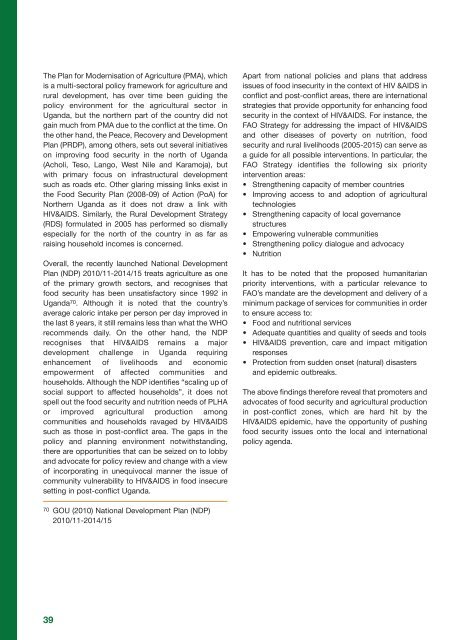Uganda Report 2012 FINAL PO:Layout 1 - ACORD
Uganda Report 2012 FINAL PO:Layout 1 - ACORD
Uganda Report 2012 FINAL PO:Layout 1 - ACORD
Create successful ePaper yourself
Turn your PDF publications into a flip-book with our unique Google optimized e-Paper software.
The Plan for Modernisation of Agriculture (PMA), which<br />
is a multi-sectoral policy framework for agriculture and<br />
rural development, has over time been guiding the<br />
policy environment for the agricultural sector in<br />
<strong>Uganda</strong>, but the northern part of the country did not<br />
gain much from PMA due to the conflict at the time. On<br />
the other hand, the Peace, Recovery and Development<br />
Plan (PRDP), among others, sets out several initiatives<br />
on improving food security in the north of <strong>Uganda</strong><br />
(Acholi, Teso, Lango, West Nile and Karamoja), but<br />
with primary focus on infrastructural development<br />
such as roads etc. Other glaring missing links exist in<br />
the Food Security Plan (2008-09) of Action (PoA) for<br />
Northern <strong>Uganda</strong> as it does not draw a link with<br />
HIV&AIDS. Similarly, the Rural Development Strategy<br />
(RDS) formulated in 2005 has performed so dismally<br />
especially for the north of the country in as far as<br />
raising household incomes is concerned.<br />
Overall, the recently launched National Development<br />
Plan (NDP) 2010/11-2014/15 treats agriculture as one<br />
of the primary growth sectors, and recognises that<br />
food security has been unsatisfactory since 1992 in<br />
<strong>Uganda</strong> 70 . Although it is noted that the country’s<br />
average caloric intake per person per day improved in<br />
the last 8 years, it still remains less than what the WHO<br />
recommends daily. On the other hand, the NDP<br />
recognises that HIV&AIDS remains a major<br />
development challenge in <strong>Uganda</strong> requiring<br />
enhancement of livelihoods and economic<br />
empowerment of affected communities and<br />
households. Although the NDP identifies “scaling up of<br />
social support to affected households”, it does not<br />
spell out the food security and nutrition needs of PLHA<br />
or improved agricultural production among<br />
communities and households ravaged by HIV&AIDS<br />
such as those in post-conflict area. The gaps in the<br />
policy and planning environment notwithstanding,<br />
there are opportunities that can be seized on to lobby<br />
and advocate for policy review and change with a view<br />
of incorporating in unequivocal manner the issue of<br />
community vulnerability to HIV&AIDS in food insecure<br />
setting in post-conflict <strong>Uganda</strong>.<br />
Apart from national policies and plans that address<br />
issues of food insecurity in the context of HIV &AIDS in<br />
conflict and post-conflict areas, there are international<br />
strategies that provide opportunity for enhancing food<br />
security in the context of HIV&AIDS. For instance, the<br />
FAO Strategy for addressing the impact of HIV&AIDS<br />
and other diseases of poverty on nutrition, food<br />
security and rural livelihoods (2005-2015) can serve as<br />
a guide for all possible interventions. In particular, the<br />
FAO Strategy identifies the following six priority<br />
intervention areas:<br />
• Strengthening capacity of member countries<br />
• Improving access to and adoption of agricultural<br />
technologies<br />
• Strengthening capacity of local governance<br />
structures<br />
• Empowering vulnerable communities<br />
• Strengthening policy dialogue and advocacy<br />
• Nutrition<br />
It has to be noted that the proposed humanitarian<br />
priority interventions, with a particular relevance to<br />
FAO’s mandate are the development and delivery of a<br />
minimum package of services for communities in order<br />
to ensure access to:<br />
• Food and nutritional services<br />
• Adequate quantities and quality of seeds and tools<br />
• HIV&AIDS prevention, care and impact mitigation<br />
responses<br />
• Protection from sudden onset (natural) disasters<br />
and epidemic outbreaks.<br />
The above findings therefore reveal that promoters and<br />
advocates of food security and agricultural production<br />
in post-conflict zones, which are hard hit by the<br />
HIV&AIDS epidemic, have the opportunity of pushing<br />
food security issues onto the local and international<br />
policy agenda.<br />
70 GOU (2010) National Development Plan (NDP)<br />
2010/11-2014/15<br />
39





